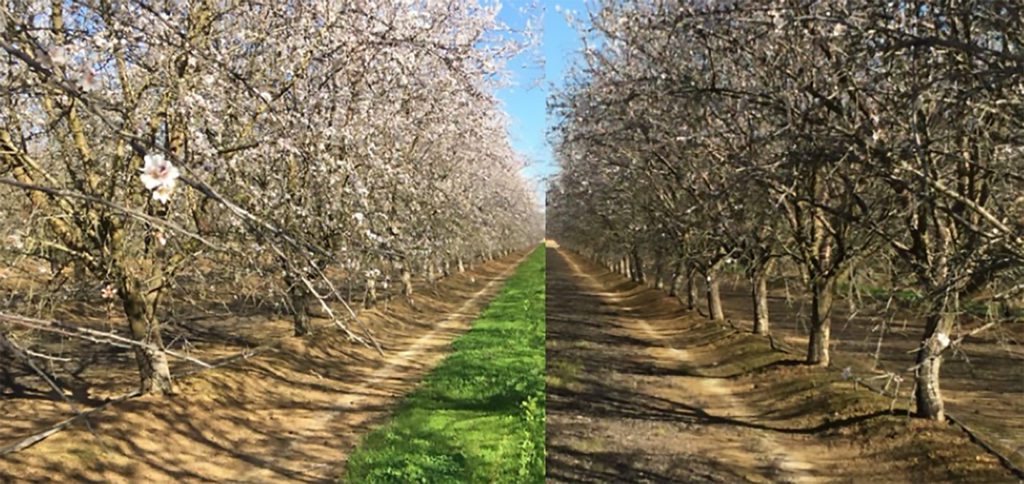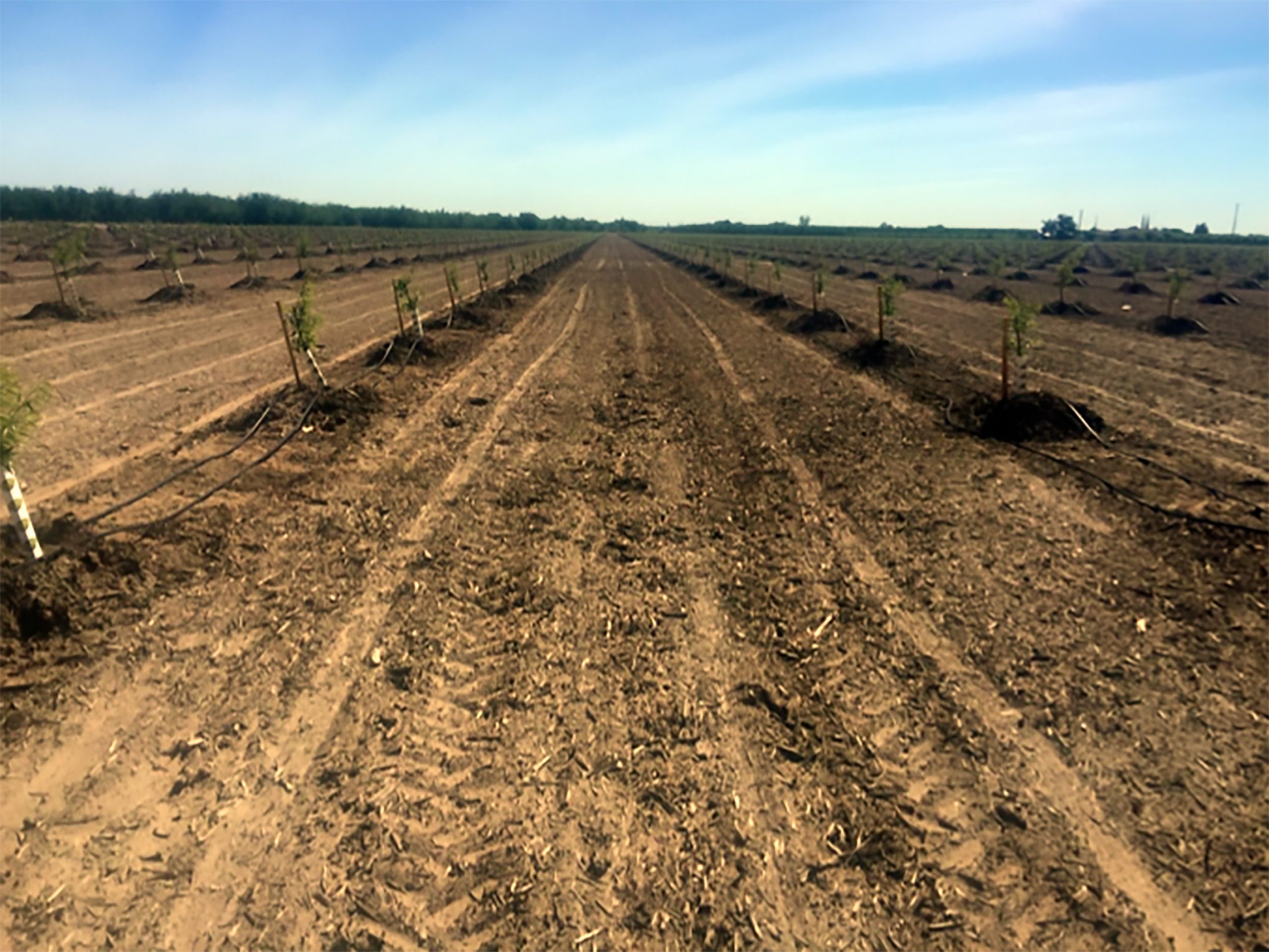Cover crops and chips from orchard removal are proving to be opportunities to enhance orchard health rather than management challenges.
Ame’lie Gaudin, assistant professor Agroecology in the Plant Science Department at University of California Davis, and Brent Holtz, University of California farm advisor in San Joaquin County presented updated research on cover crop use and orchard recycling at The Almond Conference. Almond grower Christine Gemperle shared her experiences with whole orchard recycling.
Gaudin said that orchard floors and alleyways are underutilized and present opportunities for improving production and meeting sustainability targets. Post harvest and continuing through the dormant season is the optimal time for use of cover crops in orchards, Gaudin said. Cover crops in orchards can take many forms depending on orchard age and spacing, soil type, precipitation, and region. Grower objectives and experience along with equipment availability also must be considered.
Gaudin noted that while many almond growers recognize the potential benefits of cover crops, there are reservations about implementation. Water use, orchard floor management, frost and vertebrate habitat are common questions when it comes to planted and managed cover crops. Costs and return on investments add to the uncertainty.
The benefits perceived by growers include soil health, pollinator habitat, increased water filtration and retention and tree nutrition. The concerns include difficult harvest due to debris, difficult termination, difficult management, good establishment of the crop and the challenge of transitioning to cover cropping.
Gaudin pointed out that University of California began research into cover cropping in 1922 and continues to determine how to best implement the practice in modern intensive systems. In recent trials across the rainfall gradient, the best seed choices to meet objectives were determined.
Gaudin’s advice for planting cover crops was to “treat it as a crop, nurture it.”
She said there are different species or classes of cover crops that can target different management goals. By using mixtures of species there is a higher chance of obtaining a good stand. Gaudin also warned that despite identical seeding rates and mix composition, the cover crop and biomass will likely be different every year and in different blocks.

The UC trials showed no negative impacts on almond yields and found trends toward yield increase in orchards with compacted soils when cover crops were planted. Gaudin said it is possible to get a clean harvest without conditioner. Species choices should aim for a balanced C/N ratio. Legumes decompose at a faster rate than grasses. Termination promptly post bloom using mowing and herbicide was effective. Flail mowing frequency depends on height and stage of crop. Terminating the crop later in the spring means additional mowing in the summer plus irrigation, which could accelerate the break down of crop residues.
To keep use of irrigation water low, the crop should be seeded ahead of the first rain. Gaudin said there are no significant differences in soil moisture or tree water status in the spring and very close ET values for winter cover crop and bare soils. Cumulative difference is about one inch. Water does promote biomass creation that provides other benefits in the orchard.
Studies also showed that infiltration rates improved in orchards with ground covers. Gaudin said they also found that there was a higher capacity for winter rains to be absorbed and runoff risks were reduced. However, the benefits were not retained post cover crop.
Improvements in soil health take time, Gaudin said, and cover crop biomass production is a key factor. The soil biology responds to biomass production depending on the site and cover crop mix.
Although cover crops may interfere with orchard sanitation efficacy, two possible benefits are access to orchards during wet months and the possibility that navel orangeworm mortality may increase in mummies in cover crops.
Shaking and sanitation is still necessary and feasible, Gaudin said. Sanitation prior to planting a cover crop is an option as is combining cover crop mowing with flail mowing of mummies.
Cover crops compete with weeds for resources. Gaudin said the studies found weed suppression when cover crops emerge early and a good stand is established. Early seeding ahead of winter rains is recommended.
Due to the reduction of soil to tree heat transfer with a cover crop, frost damage after bloom is a concern. Topsoil temperatures were cooler under cover crops, but Gaudin said that no ambient air temperature differences at three and five feet were observed in a study. That suggests that cover cropped orchards may not experience higher frost risks. Mowing and irrigating for frost protection can be done or a lower growing crop such as clover could be planted.
Feeding pollinators is another positive aspect of cover cropping. Gaudin said both mixes tested provided forage resources to bees during and after almond bloom. Brassicas appear more attractive than other species in these mixes. There is little or no competition for pollination with almonds.
Keys to success with cover cropping are flexibility and starting small, Gaudin said. Resources available are farm advisors, University researchers and NRCS.
“Be patient, it’s a medium-long term investment- so are your trees,” Gaudin said.
Increased soil organic matter and water holding ability are also increased with whole orchard recycling.
This process involves removal of almond trees, grinding them into small chips on site and spreading the chips on the orchard site. After disking the chips into the ground, and further site preparation, new trees are planted.
Holtz said orchard removal means grinding 25-30 years worth of photosynthesis and carbon and nutrient accumulation and hauling it away. The 25-30 years of organic matter is lost, estimated at 60 tons per acre for an almond orchard.
With whole orchard recycling, the cost of spreading the chips adds about $400 per acre, but the benefits include: N= 0.31 %, 396 lbs/ac K= 0.20 %, 256 lbs/ac Ca= 0.60 %, 768 lbs/ac and C= 50 %, 64,000 lbs/ac. The nutrients will be released gradually and naturally. Holtz noted that at the 64 tons per acre rate, the C/N ratio was out of balance, causing initial tree stunting and total weed suppression. Doubling the N applications with fertigation was done to achieve desired growth.
Holtz noted that the San Joaquin Valley Air Pollution Control District (SJVAD) recently approved a program that will reward growers with funding from $300-600 per acre up to $60,000 per year to implement whole orchard recycling.
Gemperle said her experiences with whole orchard recycling and cover crops have been positive. The new trees planted in September had some new growth prior to dormancy and the cover crop mixture has provided welcome bee forage in the orchard – which keeps her bee supplier happy.
Mustard is in bloom when the hives are placed in the orchard. After almond bloom, the clover provides forage. Her suggestion to almond growers who plan on planting cover crops is to use a battery powered ant bait spreader mounted on a quad to spread the seed down the rows.

Cecilia Parsons
Cecilia Parsons has lived in the Central Valley community of Ducor since 1976, covering agriculture for numerous agricultural publications over the years. She has found and nurtured many wonderful and helpful contacts in the ag community, including the UCCE advisors, allowing for news coverage that focuses on the basics of food production.
She is always on the search for new ag topics that can help growers and processors in the San Joaquin Valley improve their bottom line.
In her free time, Cecilia rides her horse, Holly in ranch versatility shows and raises registered Shetland sheep which she exhibits at county and state fairs during the summer.
















